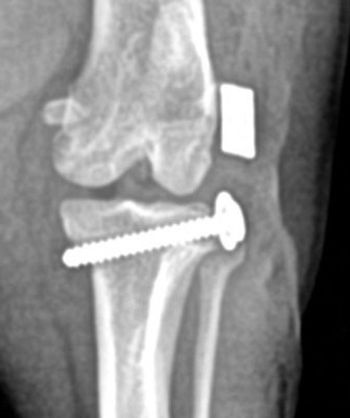
Equine ovarian tumors
Horses have a higher incidence of ovarian tumors than do any other domestic animal.
Photo: Kenneth L. Marcella
Horses have a higher incidence of ovarian tumors than do any other domestic animal.
While the percentage of ovarian tumors is reported to be 2.5 percent of all equine cancers, this particular tumor location is significant for two reasons.
Mares with ovarian tumors, specifically granulosa-theca cell tumors, which are by far the most common type of equine ovarian cancer, tend to have reproductive dysfunction, and they tend to be aggressive. Both of these problems generally cause clients to seek veterinary help.
The granulosa-theca cell tumor in the horse causes an increase in various hormone levels and an imbalance in these hormones or the changes from normal levels can profoundly affect a mare's reproductive behavior and her personality.
Behavior changes
Not all granulosa-theca cell tumors behave similarly so mares can have elevated levels of testosterone, estrogen, both or neither. Certain mares will become anestral and show no cyclical behavior. Some mares will exhibit continual estrous behavior or will have extended cycles with short periods of non-responsiveness that do not follow any pattern. Other mares will become aggressive and exhibit almost stallion-like behavior. These mares may herd and "drive" other mares as a stallion would, and they may show overt aggression and bite or kick herd-mates that they had previously gotten along with well. Occasionally, that aggression may extend to humans and some mares with granulosa-theca cell tumors have been known to bite at or threaten people in their environment.
Performance horses with granulosa-theca cell tumors may present for veterinary attention because of a vague complaint of lameness.
Performance horses
Occasionally these horses appear uncomfortable or irritable when performing, and the rider may suspect a low-grade lameness. Often back issues or saddle fit problems are mentioned. These horses may be responding to the pull of the tumor on the ovarian ligaments. As the granulosa-theca cell tumor grows in size, it can place pressure on the broad ligament of the ovary that suspends the ovary from the roof of the abdominal cavity. Horses jumping or working at speed may respond adversely to their tumor's pull on this ligament, and they may be reluctant to move forward. These horses may refuse certain gaits or leads; they may be resistant to pressure in the flank or may even kick out when requested to move in a particular manner.
All these complaints correspond to some vague cause of lameness, and a thorough reproductive examination should not be overlooked in these cases.
Many times horses on the show circuit are not being used for reproduction so clients may not complain of abnormal estrus behavior. More confusing still are those show horses receiving progesterone therapy to suppress normal estrus cycles. These mares are expected to not cycle, so anestrus will not be a clinical sign that gets mentioned to the veterinarian.
It is important to remember the possibility of a granulosa-theca cell tumor in these performance horses and to include a reproductive ultrasound exam in the lameness work-up.
Rectal palpation of mares with granulosa-theca cell tumors may or may not be abnormal. Typically the non-involved ovary is small and shows little to no follicular activity. The cancerous ovary is generally larger.
Examination
Ovarian tumors can grow to be quite large, and they are usually nodular on palpation. Ultrasound reveals some normal ovarian tissue and a tumorous area that has a "honeycombed" appearance to it. Because these tumors are mostly slow growing, the initial appearance of the ovary may not be that abnormal and sequential exams may be needed to determine a developing problem.
Normal mares in transitional estrus may exhibit many of the same clinical signs as mares with granulosa-theca cell tumors, and this is the principal differentiation to make. As mares exit winter anestrus and begin to respond to increasing day length or as they slowly stop cycling as winter approaches, they become transitional. The ovaries may produce very large follicles, which can cause the ovary to seem enlarged. Areas of multiple small follicles may also be produced that may approximate the "honey-combed" ultrasound view of an ovarian tumor. These mares can have alterations to their normal hormonal levels and may exhibit aggression or increased "crankiness" as well.
Careful evaluation of the history and a complete physical and reproductive exam can usually separate the transitional mare from the horse with an ovarian tumor. Additionally, a blood test can be done to look at various hormonal levels. An inhibin test is the last step in confirming a diagnosis of a granulosa-theca cell tumor. Inhibin is produced by the granulosa-theca cell tumor, and nearly 90 percent of mares with such growths will have elevated levels. More than 50 percent of mares with granulosa-theca cell tumors will have elevated levels of testosterone and a level of greater than 100 pg/ml is considered diagnostic. Aggression is commonly noted in these mares. Hormonal blood tests can provide a higher level of assurance that a particular mare is truly abnormal and not simply transitional.
Remember, however, that 10 percent of mares with granulosa-theca cell tumors may not have elevated inhibin levels and 50 percent may have normal testosterone. If it is suspected that a particular mare is truly transitional, many clinicians recommend increasing the amount of light that a mare in question is exposed to. This increased light regimen may take 45-60 days to affect a mare, depending on the time of year, so the ability to confirm a diagnosis with a blood test helps shorten the time to treatment for affected mares.
Treatment for mares with granulosa-theca cell tumors is surgical removal of the affected ovary.
Treatment
Mares may have ovaries removed in a number of ways. The standard approach is a traditional celiotomy under general anesthesia.
Dr. Andrew Parks, surgeon at the University of Georgia College of Veterinary Medicine, favors a ventral midline or paramedian approach and says, for tumors the size of a grapefruit or larger, "this approach makes it far easier to mobilize, ligate and remove the mass. Tumors this large have already stretched the ligaments and vessels attached to the ovaries, and possible rupture and hemorrhage can be serious complications." Surgeons at many veterinary schools, however, have been perfecting laparoscopic techniques and this developing technology may change the way that ovariectomies are performed.
Parks acknowledges this idea and feels that all equine spays, routine and for tumor removal, will be done via laparoscopic surgery in the near future.
"The use of newer electrocauteries that allows vessels of significant size to be cut and sealed," Parks says, "will soon make laparoscopic surgery a better and more realistic choice for ovariectomy in the mare."
Standing laparoscopic surgery will reduce anesthetic risk, reduce the risk of myositis and positional neuropathies, and remove the risk of post-aesthetic recovery incidents.
Once a mare has had a granulosa-theca cell tumor removed, the hormonal control over the remaining ovary is also removed.
Hormonal control
This ovary then begins to function normally, and many mares have been successfully bred following ovariectomy.
Rarely, a mare that has had one tumor removed because of a granulosa-theca cell tumor will develop a similar tumor in the remaining ovary.
Owners are usually very quick to suspect another tumor because these mares exhibit all too familiar behavior patterns. No statistics are available to draw conclusions as to the causes or possible genetic influences on these mares that develop multiple granulosa-theca cell tumors.
Dr. Marcella, a 1983 graduate of Cornell University's veterinary college, was a professor of comparative medicine at the University of Virginia. His interests include muscle problems in sport horses, rehabilitation and other performance issues.
Newsletter
From exam room tips to practice management insights, get trusted veterinary news delivered straight to your inbox—subscribe to dvm360.






